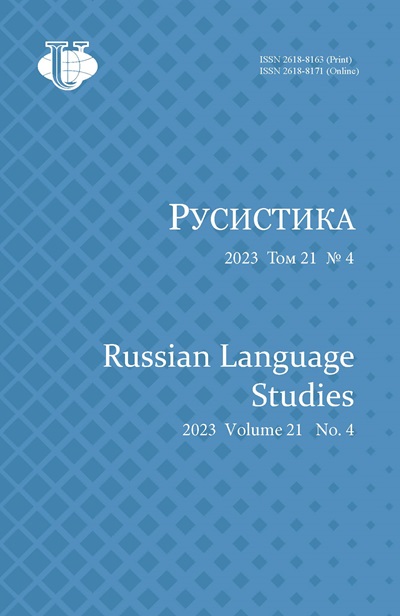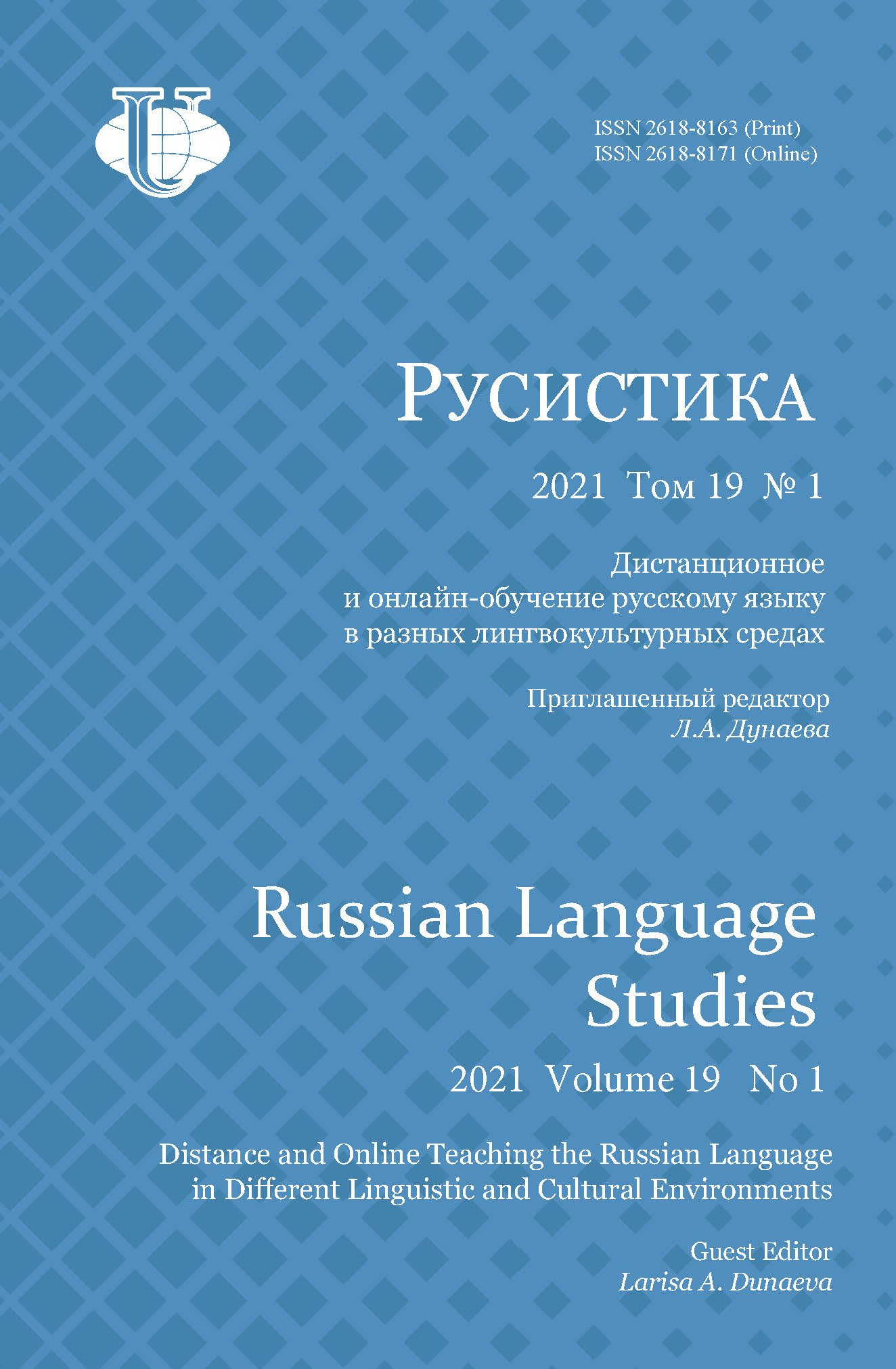The Project of Communicative Educational Resource in Russian as a Foreign Language with the Use of V-Learning Technology
- Authors: Zhiltsov V.A.1, Maev I.A.1
-
Affiliations:
- Pushkin State Russian Language Institute
- Issue: Vol 19, No 1 (2021): Distance and Online Teaching the Russian Language in Different Linguistic and Cultural Environments
- Pages: 34-50
- Section: Mediadidactics and electronic means of instruction
- URL: https://journals.rudn.ru/russian-language-studies/article/view/26129
- DOI: https://doi.org/10.22363/2618-8163-2021-19-1-34-50
Cite item
Full Text
Abstract
The article describes the project structure of an electronic educational resource in Russian as a foreign language which is based on a system of social interaction including a component of virtual simulation of the Russian language environment. The relevance of the study arises from modern trends in the development of communicative language learning and computer technology that provides the need to study and develop new efficient approaches improving the theory and practice of distance learning of Russian as a foreign language. The purpose of the study is to make a theoretical research on drawing up the structure of an electronic educational resource in Russian as a foreign language with the use of a virtual simulator of the Russian language environment as its component. The main methods are observation of modern trends in the development of electronic resources, analysis of research literature, generalization of the authors' empirical experience in the development of prototypes of learning systems based on the technology of virtual worlds and educational and game applications in the Russian language. The research materials are the works of Russian and foreign researchers devoted to the use of virtual reality technology in language learning. In the course of the study, the modern trends in the development of electronic resources were analyzed, and on this basis the basic principles and practical approaches to the formation of an electronic language environment were identified. The study resulted in theoretical and practical provisions considering an electronic educational resource in Russian as a foreign language as a living and self-developing virtual ecosystem. The results can be used to create a communication-oriented electronic educational resource on Russian as a foreign language.
Full Text
Figure 1. An example of a conference in the virtual world on the VAcademia platform. Participants are presented in the virtual world as avatars. The lecturer uses video conferencing, the session of which is projected onto a display in the virtual classroom
Figure 2. The project of the structure of an electronic educational resource based on social interaction
About the authors
Vladimir A. Zhiltsov
Pushkin State Russian Language Institute
Author for correspondence.
Email: VAJiltsov@pushkin.institute
Candidate of Pedagogy, teacher of the Faculty of Continuing Education and Modern Methods of Teaching Russian, leading engineer of the Information & Library Center
6 Akademika Volgina St, Moscow, 117485, Russian FederationIgor A. Maev
Pushkin State Russian Language Institute
Email: IAMaev@pushkin.institute
expert researcher, Head of the Information & Library Center
6 Akademika Volgina St, Moscow, 117485, Russian FederationReferences
- Aichner, T. & Jacob, F. (2015). Measuring the degree of corporate social media use. International Journal of Market Research, 57(2), 257–275.
- Antonacci, D., & DiBartolo, S., et al. (2008). The power of virtual worlds in education: A Second Life primer and resource for exploring the potential of virtual worlds to impact teaching and learning. White Paper. ANGEL Learning, Inc.
- Anzorova, S.P., & Platov, A.V. (2019). Game education based on the Second Life virtual reality platform. Global Scientific Potential, 12(105), 10–13. (In Russ.)
- Azimov, E.G., & Shchukin, A.N. (2018). Modern dictionary of methodological terms and concepts. Theory and practice of teaching languages. Moscow: Russkii yazyk. Kursy Publ. (In Russ.)
- Belozerov, S.A. (2015). Virtual worlds: Analysis of the content of psychological effects of avatar-mediated activities. Experimental Psychology, 8(1), 94–105. (In Russ.)
- Berger, M., Jucker, A.H, & Locher, M.A. (2016). Interaction and space in the virtual world of Second Life. Journal of Pragmatics, 101, 83–100.
- Bogomolov, A.N. (2008). Virtual environment for teaching Russian as a foreign language: Linguocultural aspect. Moscow: MAKS Publ. (In Russ.)
- Dilsha, M.D., & Bisny, T. (2015). An introduction to 3D Internet. International Journal of Engineering Research & Technology (IJERT), 3(28), 1–2.
- Dobrova, V.V., & Labzina, P.G. (2016). Virtual reality in teaching foreign languages. Journal of Samara State Technical University. Series: Psychological and Pedagogical Sciences, 4(32), 13–20. (In Russ.)
- Dutko, N.P. (2020). Use of Google-services in the process of teaching Russian language. Modern Pedagogical Education, (2), 135–139. (In Russ.)
- Growth from Knowledge. (2019, January 15). GfK research: Internet penetration in Russia. Retrieved November 19, 2020, from https://www.gfk.com/ru/press/issledovanie-gfk-proniknovenie-interneta-v-rossii.
- Mayes, D.K., Sims, V.K., & Koonce, J.M. (2001). Comprehension and workload differences for VDT and paper-based reading. International Journal of Industrial Ergonomics, 28(6), 367–378.
- Moore, M.G., & Anderson, W.G. (2003). Handbook of Distance Education. Mahwah, Lawrence Erlbaum Associates.
- Navolochnaya, Yu.V. (2019). Social networks use in foreign language teaching practice. Philological Sciences. Issues of Theory and Practice, 12(2), 267–272. (In Russ.)
- Orekhova, I.A. (2003). Yazykovaya sreda: Popytka tipologii [Language Environment: An attempt at typology]. Moscow, Pushkin State Russian Language Institute. (In Russ.)
- Orekhova, I.A. (2019). Virtual language environment, real language environment and language personality. Slavic Culture: Origins, Traditions, Interaction: XX Cyril and Methodius Readings: Proceedings of the International Scientific and Practical Conference, Moscow, May 22–24, 2019: Collection of articles. Мoscow. (In Russ.)
- Osadchii, M.A., Maev, I.A., & Zhiltsov, V.A. (2018). Russian language 3D-quest: Creation, approbation, opportunities of practical use. Russian Language Abroad, (1), 4–9. (In Russ.)
- Osadchii, M.A., Maev, I.A., Zhiltsov, V.A., & Olkhovskaya, A.I., et al. (2018). Educational-game software complex “Operation ‘Smartkot’ ”. Registration Certificate of a Computer Program RU 2018664266. (In Russ.)
- Petrovskii, A.V. (2012). The need to “be a person”. Bulletin of Psychological Practice in Education, 9(4), 87–91. (In Russ.)
- Qiu, Xin. (2020). Virtual reality as a tech tool for students studying Russian in China. Russian Language Studies, 18(3), 328–341. (In Russ.) https://doi.org/10.22363/2618-8163-2020-18-3-328-341
- Samosenkova, T.V., Savochkina, I.V., & Goncharova, A.V. (2019). Mobile learning as an effective educational technology in the classroom in Russian as a foreign language. Perspectives of Science & Education, 38(2), 307–319. (In Russ.)
- Sevastyanova, O.V. (2019). The place and role of the Internet in the modern economy. Trends of the Internet and Digital Economy Development: Proceedings of the All-Russian Scientific-Practical Conference with International Participation, Simferopol – Alushta, May 30 – June 1, 2019 (p. 97–98). Simferopol, IP Zueva T.V. Publ. (In Russ.)
- Shih, Y.C. (2014). The meeting point of second life and Web 2.0: Self-discovery for writing. Cyber Behavior: Concepts, Methodologies, Tools, and Applications (pp. 689–707). Pennsylvania, IGI Global. (In Russ.)
- Steinkuehler, C. (2008). Massively multiplayer online games as an educational technology: An outline for research. Educational Technology, 48(1), 10–21. Retrieved December 6, 2020, from http://www.jstor.org/stable/44429539.
- Thomas, C.E., Richmond, V.P., & McCroskey, J.C. (1994). The association between immediacy and socio-communicative style. Communication Research Reports, 11, 107–115.
- Tu, C.H., & McIssac, M. (2002). The relationship of social presence and interaction in online classes. The American Journal of Distance Education, 16(3), 131–150.
- Universities in Second Life. Retrieved November 19, 2020, from https://secondlife.com/destinations/learning/universities/.
- Wenkel, C., & Kingsley, J. (2009). Higher education in virtual worlds: Teaching and learning in Second Life. Bingley, Emerald Group Publishing Limited.
- Wilson, D.W., Lin, X., Longstreet, P., & Sarker, S. (2011). Web 2.0: A definition, literature review, and directions for future research. A Renaissance of Information Technology for Sustainability and Global Competitiveness: Proceedings of the 17th Americas Conference on Information systems, Detroit, Michigan, August 4–8, 2011. Detroit, Association for Information Systems.
Supplementary files

















